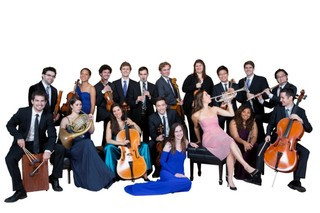|
Back
The Jungle Books New York
National Sawdust, 80 North 6th Street, Williamsburg, Brooklyn
05/03/2016 -
Turning Point:
Pierre Boulez: Dérive 1
Tōru Takemitsu: Entre-temps
Matthias Pintscher: Figura II/Frammento
Ruth Crawford Seeger: String Quartet: 3. Andante
Arnold Schoenberg: Kammersymphonie No. 1, Opus 9 (Arranged by Anton Webern)
ACJW: Jacqueline Cordova-Arrington (Flute), James Riggs (Oboe), Stanislav Chernyshev (Clarinet), Michael James Smith (Piano), Garrett Arney (Percussion), Siwoo Kim (Violin), Kristin Lee (Guest Violin), Dana Kelley, Danny Kim (Violas) Andrea Casarrubios, Caleb van der Swaagh (Cello), David Fulmer (Guest Conductor)

ACJW (© Jennifer Taylor)
While “education” should be, at most, an incidental adjunct to a good concert, the music at National Sawdust inevitably turns orthodox ideas upside-down. Whether it be the anecdotal enlightenment of an Esa-Pekka Salonen, or, as last night, a new vision of the so-called Schoenberg revolution, one exits not only with feelings Ye Awesomest Brain Enlarged.
The concert last night, with many “alumni” of the ACJW, was called “Turning Point”, and referring obviously to the music of Arnold Schoenberg. Yet this was the great surprise. Like all surprises, it came at the end.
Before Arnold Schoenberg’s First Chamber Symphony, we were treated to a quartet from Schoenberg’s “children”. Composers from three different continents, sharing the joys of atonality.
Outside of that, there was little commonality. The late Pierre Boulez, the so-called leader of the Second Viennese School, was represented with the relatively well-known Dérive 1. These were supposedly variations, though nobody who hadn’t played them or followed the score, would know this. Instead, we had the Boulez sense of color here, with the unusual flute, clarinet, piano, vibraphone, violin and cello, bouncing music off each other in a series of trills, roulades, spirals and eddies.
Schoenberg would have been intrigued, if only by Boulez’s French paradox: “I make up rules,” he once said, “in order to break them.”
Takemitsu’s Entre-temps was typical for the composer: an atmosphere for strings followed by James Riggs’s oboe interruptions. It was purposely murky, a Japanese non-Zen riddle, and its complexity probably had its own rules.
Following that came the only composer living today, the prodigious pianist, conductor (Matthias Pintscher will be leading the Juilliard Orchestra in Mahler’s First next month) and composer. Mr. Pintscher has no one “style”. Every single piece I’ve heard in New York takes one by surprise. His string quartet here was as enigmatic as its title, Figura II/Frammento, and with no program description (ACJW takes it for granted that its audiences are as knowledgeable as they are), I could only congratulate the players (Messrs Lee, Siwoo, Kim and Van der Swaagh) for keeping the fragments moving until the last whisper.
The first honest surprise of the evening was a short Andante from the 1931 String Quartet. Ms. Seeger was not only Pete’s stepmother, but studied with virtually every great teacher in Europe and America–yet her music is rarely played these days. This one movement, with the same artists as the Pintscher, was also new to me: it was an arc of closely knit harmonies, going further and further upward...
And I can only wonder about its connection with the rest of the String Quartet.
Back to education. Arnold Schoenberg wrote this Chamber Symphony 110 years ago–a duration analogous to Beethoven’s doodlings in earliest chamber music in 1791 and Schoenberg’s own Transfigured Night in 1901. Yet any concert manager who puts Schoenberg on the program today can depend only on empty seats!
This piece, though, brought from the original 15 players to five very busy musicians in the Webern transcription, while possibly the turning point, was a most engaging piece of music.
What I learned here through music, not textbook, is that music is not and never has been a saltatory history. Obviously it never leaped from Baroque to Classical. And just as obvious, Arnold Schoenberg never gave an Archimedes “Eureka!” when composing with the 12-tone scale.
Rather, as this most accessible 20-minute work showed last night, his musical language was partly pictorial (Richard Strauss), partly Late Romantic (Brahms) and–like a racing car driving off and on the designated track–eccentric (Mr. Schoenberg himself).
At its first performance, the audience didn’t catcall or walk out, as in Stravinsky’s Rite. Rather, they sat silently, stunned, not sure what to do.
Last night, this music proved to be witty, melodic, the cerebral puzzles secondary to an emotional jaunt. A century ago, this was a jungle of notes, with rare adventurers daring to enter. The players last night never considered it a jungle. It was a well-designed forest, its one-time thickets now aglow with the most gorgeous musical blossoms.
Harry Rolnick
|